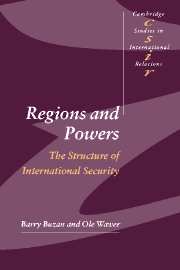Book contents
- Frontmatter
- Contents
- List of illustrations
- Preface
- List of abbreviations
- 1 Patterns of regional security during the Cold War
- 2 Patterns of regional security post-Cold War
- Part I Introduction: developing a regional approach to global security
- Part II Asia
- Part III The Middle East and Africa
- Part IV The Americas
- Part V The Europes
- Introduction
- 11 EU-Europe: the European Union and its ‘near abroad’
- 12 The Balkans and Turkey
- 13 The post-Soviet space: a regional security complex around Russia
- Conclusions: scenarios for the European supercomplex
- Part VI Conclusions
- Glossary
- References
- News media
- Index of names
- General Index
- CAMBRIDGE STUDIES IN INTERNATIONAL RELATIONS
11 - EU-Europe: the European Union and its ‘near abroad’
Published online by Cambridge University Press: 05 December 2009
- Frontmatter
- Contents
- List of illustrations
- Preface
- List of abbreviations
- 1 Patterns of regional security during the Cold War
- 2 Patterns of regional security post-Cold War
- Part I Introduction: developing a regional approach to global security
- Part II Asia
- Part III The Middle East and Africa
- Part IV The Americas
- Part V The Europes
- Introduction
- 11 EU-Europe: the European Union and its ‘near abroad’
- 12 The Balkans and Turkey
- 13 The post-Soviet space: a regional security complex around Russia
- Conclusions: scenarios for the European supercomplex
- Part VI Conclusions
- Glossary
- References
- News media
- Index of names
- General Index
- CAMBRIDGE STUDIES IN INTERNATIONAL RELATIONS
Summary
EU-Europe is the most institutionalised part of the world. Although the exact nature of the EU is hotly debated, its experiment in post-sovereign politics undoubtedly pushes peaceful, regional integration to new limits. Europe is developing unique forms of political organisation neither by replicating the state form at a higher level, nor by annulling the old order, but by mixing a continuity of sovereignty with new forms (Rosenau 1990; Ruggie 1993; Wæver 1995a). Consequently the European security landscape is becoming distinctive. The traditional near-monopoly of the state on security status and security action is challenged in Europe, where numerous other referent objects from mini-region to the EU itself, from environment to ‘universal’ political values, are acted upon in a security mode. Securitisation theory enables one to see this picture different from the one of only states (while allowing also for that possibility).
During the Cold War, the area that would become EU-Europe was overlaid and the dominant security concerns in the region were defined externally. Security politics during the Cold War mostly consisted of struggles over how intensely to securitise superpower rivalry versus desecuritise it through détente or deterrence. Post-Cold War EU-Europe was ‘set free’ – despite continued US involvement in one of the leading organisations, NATO – and the security agenda at first fragmented into numerous loosely connected concerns raising serious questions about both the spatial interconnectedness of ‘Europe’ and the thematic coherence of ‘security’.
- Type
- Chapter
- Information
- Regions and PowersThe Structure of International Security, pp. 352 - 376Publisher: Cambridge University PressPrint publication year: 2003
- 2
- Cited by



